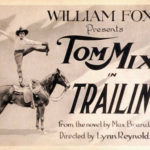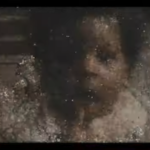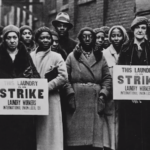Hagley Library’s Collection Tells How Industry Worked
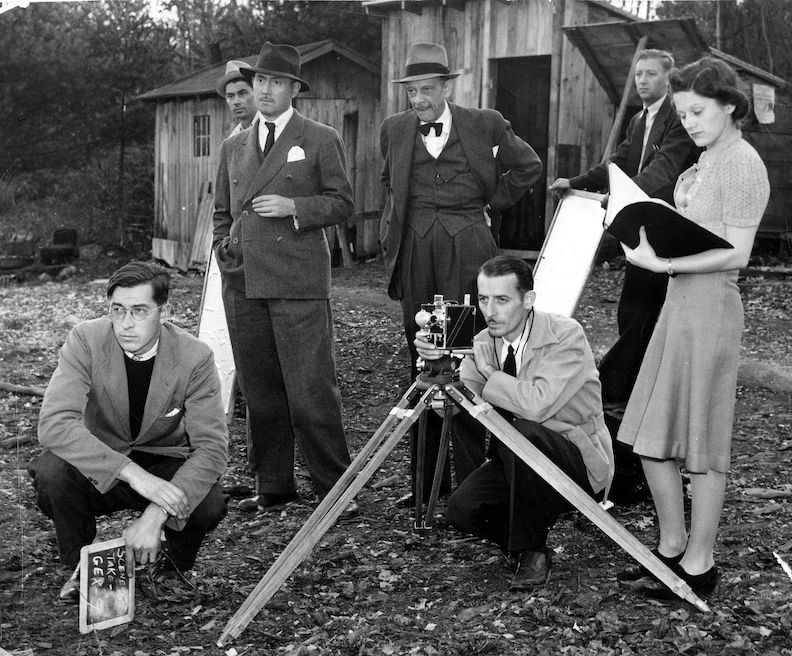
Cinecraft Founders Ray Culley (behind the camera) and Betty Culley (holding script), circa 1940. All images courtesy: Hagley Museum and Library, and Digital Archives.
How were workers in the mid-20th century assured that capitalism and industrialism were wholesome forces? How did consumers in 1947 learn about the introduction of FM radio, and how the technology operated? If you were an industrialist, how did you tell members of the public about your industry, if otherwise word would likely never get out?
Often, the good news was spread by sometimes hokey but evidently effective “industrial” films. Those could be — and they still can be, today — quite lengthy quasi-advertisements of 30 minutes or more for companies large and small.
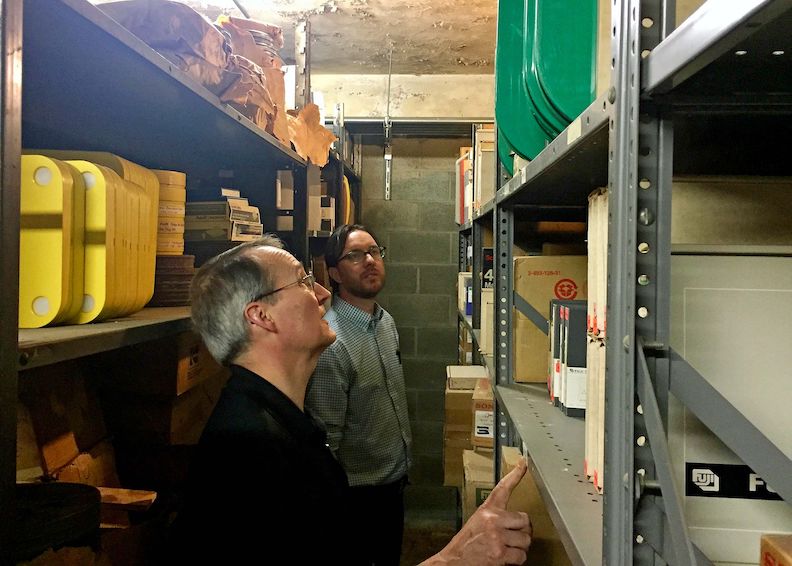
Current Cinecraft Board Chair Neil McCormick and Hagley Curator Kevin Martin examine the Cinecraft film vault in 2017.
The variety of “industrial” films and the pitches in examples of this sprawling genre were enormous. That is evident in the Cinecraft Production collection, which the Hagley Library in Wilmington, Delaware, has acquired and is promoting on its website.
It is “one of the most comprehensive collections from an industrial film company in the country and the largest ever motion picture acquisition for the Hagley Library,” says the institution’s curator, Kevin Martin. The collection includes films watched in classrooms, auditoriums, churches, and company and neighborhood theaters, and at corporate events, board meetings, luncheon clubs, and union halls.
That makes the collection a great fit for the Hagley’s mission to document the history of business, industry, and technology, which it pursues with a vast collection of business records and archives at its home at the historic DuPont powder yards on the banks of the Brandywine River in Wilmington.
Given its mission, the Hagley gratefully received the collection from Maria Keckan, Cinecraft’s President and CEO, and Neil McCormick, the Chair of its Board, over a year ago, and has been processing it since then to prepare it for public viewing and use, which has now begun.
The Cinecraft collection includes not only “industrials,” but also early filmed television commercials — clearly a kindred moving-image genre — as well as a made-for-TV film series, the first televised “infomercial” (another, later related genre), and one of the first television cooking shows.
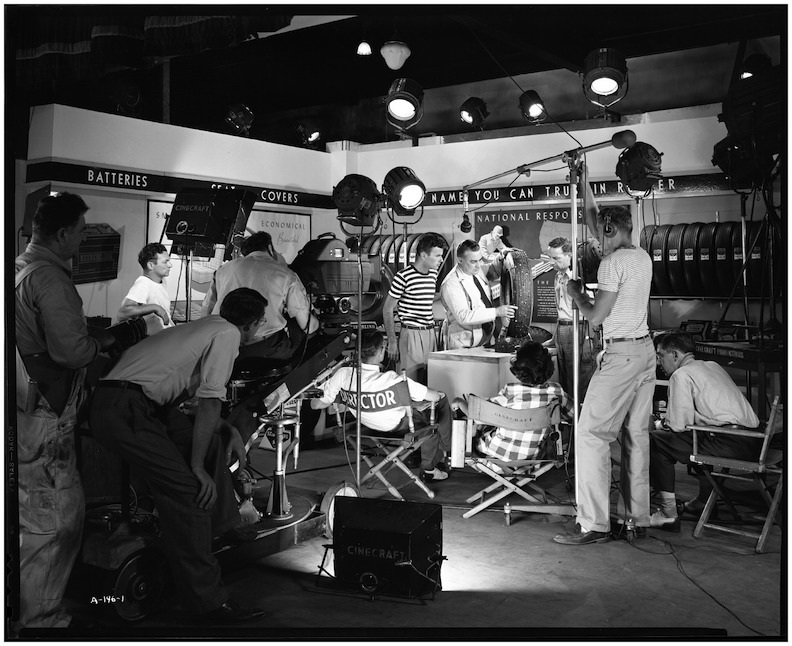
Production still from The Miracle on Mulberry Street, a 1948 film shot in Rocky River, Ohio, for the Seiberling Rubber Company of Akron, Ohio, about residents of a suburban street and their safety concerns, which are allayed by demonstrations of car tires that can withstand nails and reseal if punctured.
Almost all the films in Cinecraft’s donation were from its own studios, but also among the items was work from some other studios, including the only known print of a silent film, The Heart of Cleveland, made in 1924 by the Rothacker Film Manufacturing Company for the Cleveland Electric Illuminating Company to promote the latter’s expanding electricity services beyond the urban core of that city. (A pilot makes an emergency landing in a farm field, then the next day flies the farmer’s two teenager children to the city — “where power, prosperity, and progress are spelled e-l-e-c-t-r-i-c-i-t-y” — to show them the marvels of the modern utility, including Lake Shore Station where it is generated; later the family revels in their newly electrified farmhouse.)
Cinecraft, founded in 1939 by Betty and Ray Culley, today is the United States’ longest-surviving corporate and industrial studio in a sector of the motion picture industry that from the 1940s to the 1960s boasted hundreds of studios.
Based in Cleveland, Ohio, Cinecraft is privately owned and has had only three owners in its 81 years of operation. Its donated collection has more than 6,000 cans of film from about 1,500 productions, along with 1,000 film scripts and related records and 3,000 studio production photographs and negatives. Most of the collection consists of master materials, and a significant portion of the films are held in no other library or archive.
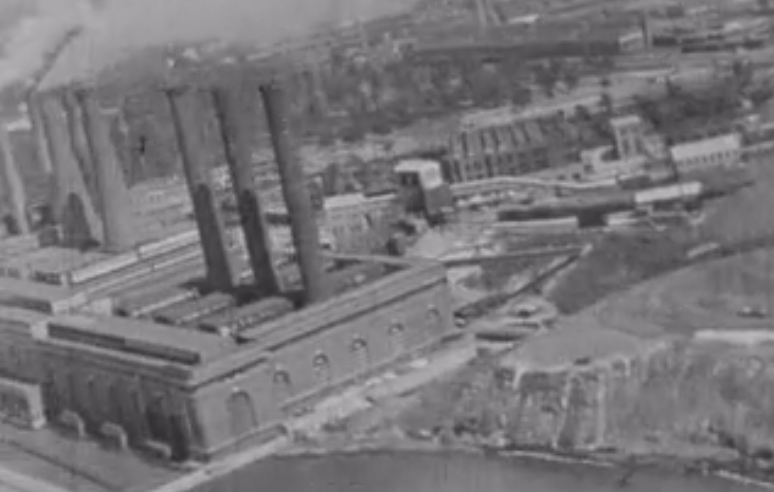 Many of the films make for fascinating viewing, even today. Take, for instance, The Romance of Iron and Steel (left), a 21-minute paean to industrialization made in 1938 by Cinecraft co-founder Ray Culley (1904-1983). It depicts the heroic accomplishments of the Armco Steel Corporation, founded by George M. Verity, who appears at the film’s conclusion.
Many of the films make for fascinating viewing, even today. Take, for instance, The Romance of Iron and Steel (left), a 21-minute paean to industrialization made in 1938 by Cinecraft co-founder Ray Culley (1904-1983). It depicts the heroic accomplishments of the Armco Steel Corporation, founded by George M. Verity, who appears at the film’s conclusion.
First, though, viewers are treated to a depiction of the process of turning iron ore into steel.
The profits of the industry, we learn from the narrator and depictions, include that “Armco men work, live, and play in pleasant surroundings: a man who is proud of his home, his community, his company, and its products carries a spirit that is reflected in the work he does, and this is typical of enlightened American industry. Parks, playgrounds, swimming pools, baseball, tennis, golf… These represent healthful recreations and play a wholesome part in the lives of American workers. And so in Armco’s great plants in this country and overseas, there is a conscientious endeavor to promote a spirit of understanding, loyalty, and cooperation.”
It all amounts to a “romance of iron and steel,” the narrator concludes, before Armco founder George M. Verity appears to extol the company’s and its workers mutual interests: “Only as men can learn to live and work together in understanding and happiness can life bring to all of us its richest rewards.”
Cinecraft’s clients were many and varied, a who’s who of American industry: DuPont, Westinghouse Electric Corporation, Standard Oil Company (Ohio), B. F. Goodrich and Seiberling Tire and Rubber, Republic Steel and Youngstown Sheet and Tube, Ohio Bell Telephone Company, Owens Corning, General Electric Company, Carling Brewing Co., and scores of other companies, trade associations, and government agencies.
To make its productions even more compelling, Cinecraft often hired celebrities. So, calls went out to the likes of media mogul Merv Griffin, film and vocal star Danny Kaye, and actors Tim Conway (The Carole Burnett Show) and Alan Alda (M*A*S*H). Many who appear in the collection are far less known today than in generations past: Louise Winslow, the “Martha Stewart” of the first years of television; Chet Huntley, the co-anchor of NBC’s evening news for 14 years; Basil Rathbone, “Sherlock Holmes” in 14 Hollywood films; Joe E. Brown, famous comedian of the 1930s and 1940s…
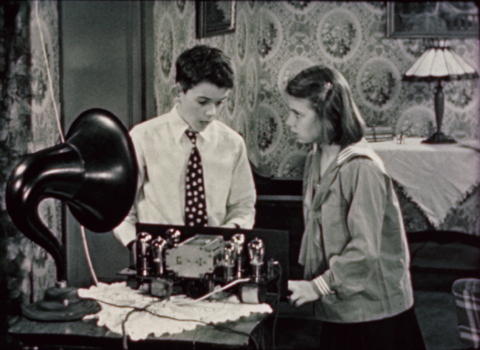 Others are timeless (Richard Nixon, among those).
Others are timeless (Richard Nixon, among those).
The subject matter is highly varied, and many of the films make for amusing and diverting viewing. In his 1947 film, Naturally – It’s FM (left), Culley explains radio technology through a series of scenes between a fellow who condescendingly instructs his tweenie neighbor and later wife in how radio, first AM and then FM, works. Eventually we learn — and this is the real point of the whole production — that it is GE which “brings enjoyment and entertainment out of the air. And you can thank the research men of radio for the pleasure it brings you.”
GE, we are reminded, helped pioneer FM radio and brought it from the experimental stage to the place where we can enjoy it.”
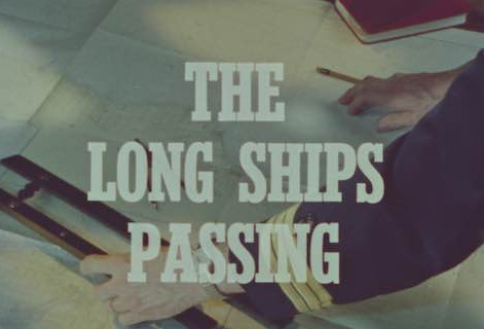 The Long Ships Passing, made in 1960, pitches the benefits of shipping iron ore, coal, limestone, grain, and other commodities via the Great Lakes, the adjoining five inland seas of North America. Created to recruit crewmen to the ships, it depicts life on board and includes an animation to show how the enormous Soo Locks of Lake Superior functioned.
The Long Ships Passing, made in 1960, pitches the benefits of shipping iron ore, coal, limestone, grain, and other commodities via the Great Lakes, the adjoining five inland seas of North America. Created to recruit crewmen to the ships, it depicts life on board and includes an animation to show how the enormous Soo Locks of Lake Superior functioned.
It remains fascinating, even now.
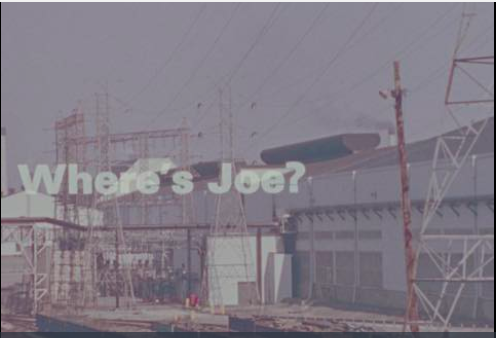 Many of the films in the collection project attitudes and perspectives of their day, some still current. For example, Where’s Joe?, produced for United Steelworkers of America, is an impassioned plea that American industrial jobs be retained for American workers: “Joe has been replaced by Jose, Hans, or Toshika, all productive steelworkers, but not in the U.S.” This will not do, the film argues, because steel is a critical American component, and disruptions to the industry risk provoking strikes, hoarding of inventories, and all hell breaking loose.
Many of the films in the collection project attitudes and perspectives of their day, some still current. For example, Where’s Joe?, produced for United Steelworkers of America, is an impassioned plea that American industrial jobs be retained for American workers: “Joe has been replaced by Jose, Hans, or Toshika, all productive steelworkers, but not in the U.S.” This will not do, the film argues, because steel is a critical American component, and disruptions to the industry risk provoking strikes, hoarding of inventories, and all hell breaking loose.
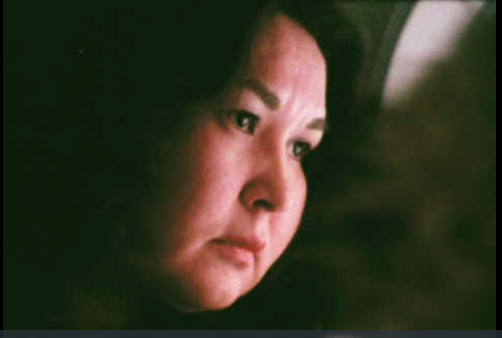 The issues raised in Where the River Enters the Sea, from 1982, also remain current. In a fictionalized story, the members of an Iñupiat Inuit family (referred to as “Eskimos”) in a remote Alaskan village discuss the challenges of adapting to Western culture while preserving their traditions. Made with the cooperation of the Alaska Native-owned NANA Regional Corporation, and sponsored by Standard Oil Company (Ohio) it weighs the fulfillment of age-old ways of life against the benefits of joining the Western cash economy, and advances the contention that a compromise is possible.
The issues raised in Where the River Enters the Sea, from 1982, also remain current. In a fictionalized story, the members of an Iñupiat Inuit family (referred to as “Eskimos”) in a remote Alaskan village discuss the challenges of adapting to Western culture while preserving their traditions. Made with the cooperation of the Alaska Native-owned NANA Regional Corporation, and sponsored by Standard Oil Company (Ohio) it weighs the fulfillment of age-old ways of life against the benefits of joining the Western cash economy, and advances the contention that a compromise is possible.
“There is more choice now, especially for the young,” an elder states.
Explore a portion of the Cinecraft collection here. Watch a highlight reel. Learn more about Cinecraft Productions.
— Peter Monaghan
Previous Post: The Israel Film Archive, Online
Next Post: Looking Again at Eyes on the Prize

